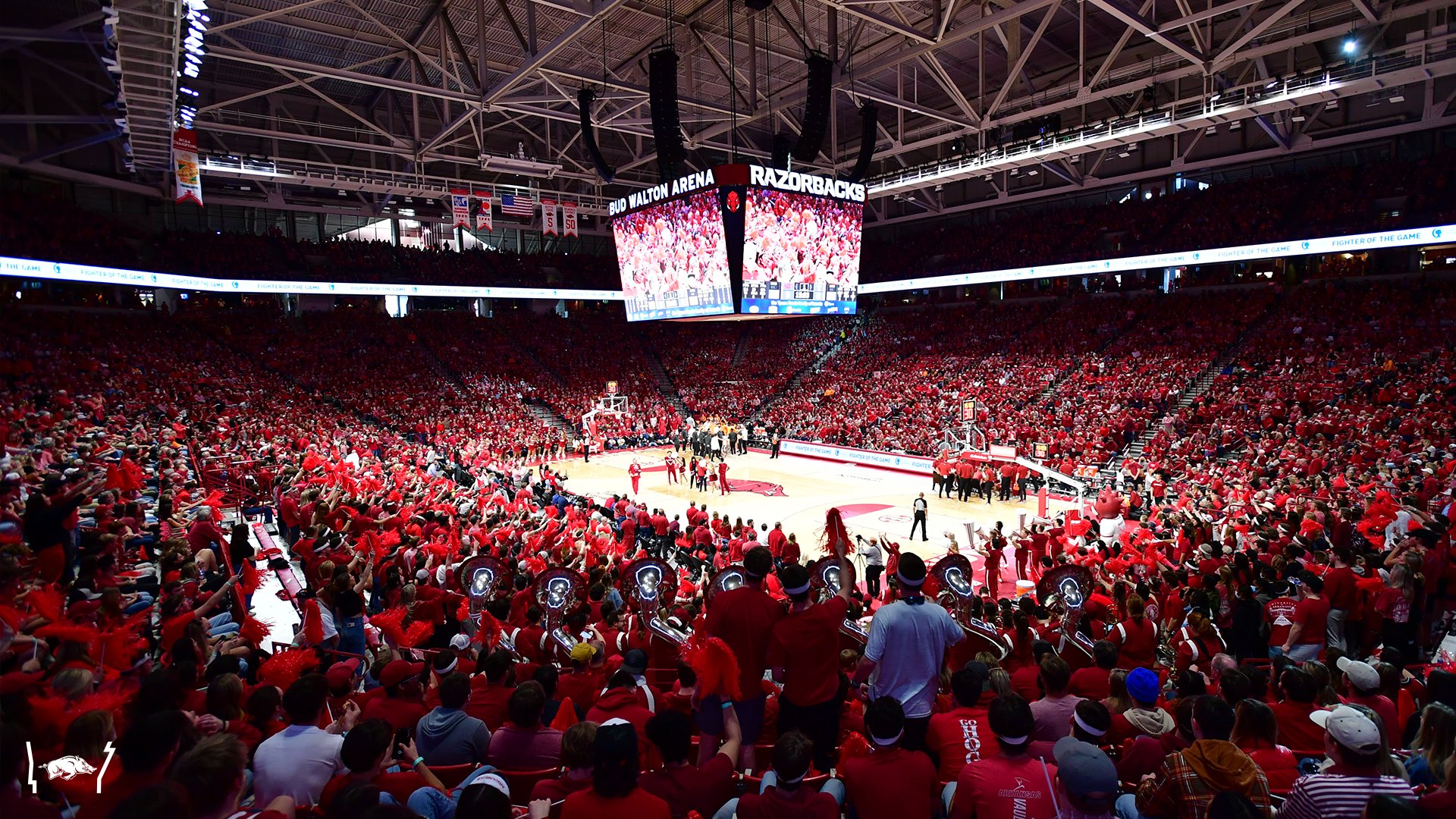It’s been a season to remember at Bud Walton Arena. The Razorbacks’ last three games at home have been wins over AP top 20 teams. The ride ends Wednesday night with a dangerous LSU team paying the Hogs a visit.
Yes, this one has trap game written all over it. Arkansas is coming off an emotional win over Kentucky and has a huge trip to Knoxville looming on Saturday. It would be easy to overlook the unranked Tigers. LSU (20-9, 8-8) has had a weird season. Their record isn’t that great, but they are ahead of Arkansas in the NET and — spoiler alert — in our models too. We will take a closer look into why that is in this post.
Another reason that this is a trap game is Xavier Pinson. The LSU point guard missed Arkansas’ 65-58 win in Baton Rouge, but he’ll be back on Wednesday. LSU’s offense isn’t great, but it’s much better with Pinson in the lineup.
Meet the Tigers
Confused? Check out the advanced stats glossary to learn more about the stats cited here.
As always, our two models make picks. The matchup model constructs a predicted box score based on team stats, while the traditional model uses each team’s adjusted efficiencies and adds a momentum factor.
- Matchup Model: Arkansas 72, LSU 71
- Traditional Model: Arkansas 66, LSU 62
Team Profile

The madness starts just by looking at LSU’s overall numbers. The model thinks LSU is about 3 points better on a neutral court and yet, the Hogs and Tigers have the same average game score this year (75). In just each team’s last 10 games, Arkansas has an 81 and LSU has a 62. Again, we’ll look into why in a second.
The big thing you notice with LSU is the difference between their offense (109th) and their defense (1st). LSU’s defense drives everything the Tigers do. The offense just tries to be good enough.
Personnel Profile

Let’s rank the best players in the SEC by BPM, shall we?
- Tari Eason, LSU +13.5
- Walker Kessler, Auburn +12.5
- Oscar Tshiebwe, Kentucky +11.8
- Jabari Smith, Auburn +9.3
- Santiago Vescovi, Tennessee +8.3
Interesting. Eason probably wasn’t your first choice. But all metrics say he’s that good. He’s second in the SEC in win shares per 40 minutes, trailing only Tshiebwe. And among all non-Kentucky SEC players who have been on the floor for half of their team’s minutes this season, his plus-minus of +22 per 100 possessions is the best. So, yeah, he’s that good.
A closer look at Eason’s numbers and it’s not hard to see why he’s so good. His shooting percentage is solid (56% EFG), he’s one of the best in the conference at getting to the line (0.47 free throws per field goal), he’s an above-average offensive rebounder (12%), his assist rate of 10% is more like a guard than a power forward, and he leads the SEC in steal rate (5%).
Eason, Darius Days, and Mwani Wilkinson form an athletic frontcourt that is the key to LSU’s offense. The guards, on the other hand, have struggled. Pinson dishes out a ton of assists (32%), but he turns it over on a staggering 24% of his possessions. Backcourt mate Eric Gaines somehow manages to turn the ball over at an even higher rate (25%) and without all of Pinson’s assists. Neither guard shoots particularly well, either.
In the first matchup (no Pinson), LSU’s guards combined for 16 points on 21 shot opportunities (yikes), with 6 assists against 8 turnovers (also yikes).
When Arkansas has the rock
Okay, we have to talk about LSU’s defense. Yes, it is ranked #1 in the country. But that ranking is slightly deceiving. That’s not to say LSU’s defense isn’t really good, it’s just that LSU’s defense isn’t as good right now as it was in November and December.
Check it out for yourself:
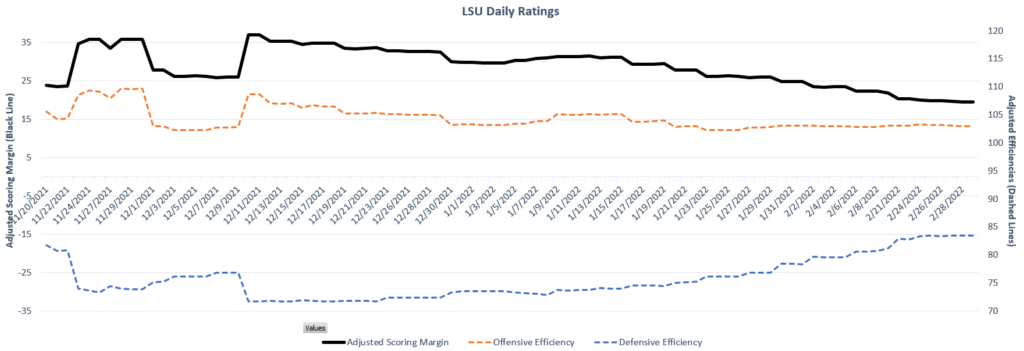
The blue line is LSU’s Adjusted Defensive Efficiency for every day since November 20th, 11 days after the season began. LSU spent more than a month with an ADE of less than 80, which was best in the nation by a very large margin. We’re talking historically good.
But look what has happened since. Just in the last 5 weeks (10 games), LSU’s season ADE has gone from 75 to 83. That’s still best in the country, but we’re no longer tearing up the record books. And for it to rise so significantly so suddenly, it’s pretty clear that LSU is not playing at a 75 or an 83 right now. That’s because these daily ratings bake in everything that happened before.
So let’s make each game independent to see if the trend is even stronger. Here are LSU’s game scores for each game:
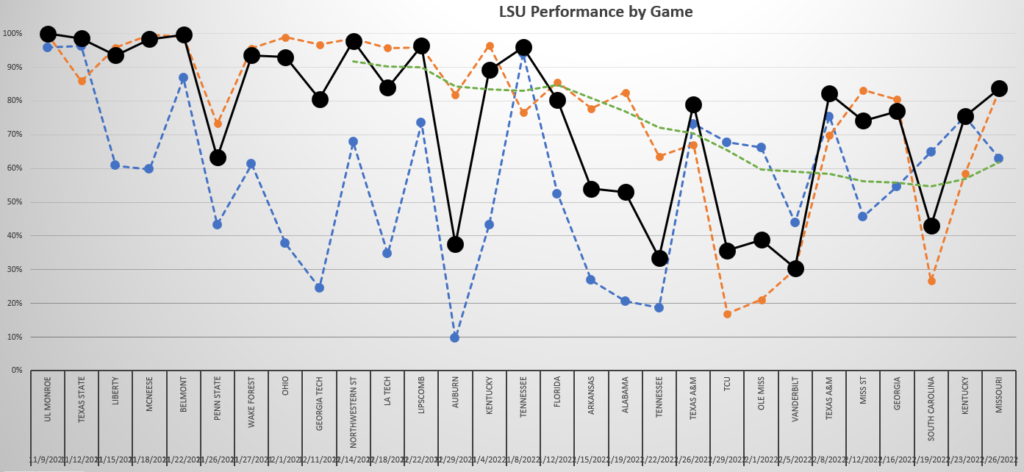
Defense is the orange line. Note the almost-unbroken string of 95+ defensive grades in late November through December. That built up LSU’s season rankings. And note what’s happened since. LSU earned a respectable 78 in the first meeting with the Hogs, but they’ve only managed to be even that good in 4 of 12 games since, with their four worst performances of the season all coming in the last nine games.
To be clear, LSU’s early-season defensive dominance is still impressive. They beat UL Monroe 101-39. They beat Belmont — a team with a bubble resume — 83-53. Other early-season opponents scored 46, 49, 53, 58, and 59 points against them. But they’ve allowed 70 points or more six times since January 29th and are 0-7 when the opponent scores 70+. Arkansas and Tennessee are the only teams to beat them without scoring 70.

Will Wade’s first few LSU teams were great on offense and terrible on defense. So last year he made the switch to a Virginia-style pack line defense. It didn’t yield immediate results: 2021 LSU still let opponents get to the rim too much and fouled way too much. But this year, the Tiger pack line is deadly. As you can see, LSU still fouls way too much, but they do everything else pretty well.
The two main ways LSU’s defense has gotten worse are turnovers and free throws allowed. The Tigers were forcing turnovers on 26% of possessions on January 13th, but now, that all-season figure is down to 24%. And on January 13th, LSU’s season average for free throws attempted per field goal attempted (FTA per FGA) was 0.30; now it is 0.37. More athletic teams are finding ways to protect the ball and take advantage of the aggressive LSU defense.
So what is a pack line? Simply put: it’s a defense that coaches off-ball defenders to stand in the “gaps” between the ball and their man. This tends to lead into defenders congregating into the high post, AKA “the pack line”:
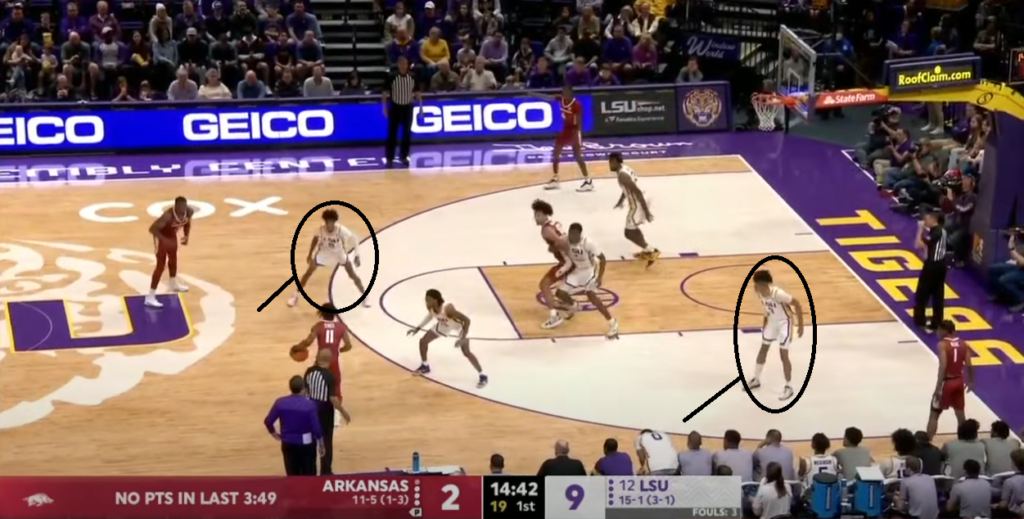
Notice LSU’s defenders in the gaps to either side of the ball. Also notice how there’s no chance for dribble penetration, as the defenders are “packed” into the high post and able to help against any driver.
This defense is very common across college basketball for a reason and is very tough to attack. But there are ways. Here are the big three:
#1 Good Spacing
You don’t see the pack line in the NBA because NBA offenses are too good at spacing and can hit the open 3-pointers that the pack line allows:

The pack-line tends to give up a lot of open and semi-open 3-pointers, because off-ball defenders aren’t on shooters, only in the gaps. Nearly half of all field goals attempted against LSU are 3-pointers this season. Good spacing will create open shots, and we all know what happens when a well-spaced offense gets open shots against a pack line:
UMBC aside, you can see why the pack line is so popular in college: the offenses just can’t consistently hit those catch-and-shoot 3-pointers. Arkansas is no exception — the Hogs are 275th from 3 and were 5 of 17 from downtown in the first meeting, though they did hit two big ones during the 17-2 run to close the game. If the Hogs get hot from downtown this should be an easy win, but assuming they don’t, they have other options to attack.
#2 Offensive Rebounding
Offensive rebounds are another danger to pack lines like LSU’s. That’s because in order to maintain defensive spacing, LSU usually switches every ball screen. This limits who LSU can put on the floor: 6’11 center Efton Reid, for example, has to be protected in ball screen situations since he will likely struggle if isolated by JD Notae. If Arkansas can punish LSU for switching the same way the Hogs punished Auburn for switching, then LSU will have play a smaller, more athletic lineup.
Smaller defensive lineups yield offensive rebounds. So, too, do schemes that aren’t purely man, because defenders aren’t always in position to box out when a shot goes up.
This sequence sums up the vulnerabilities of the pack line:
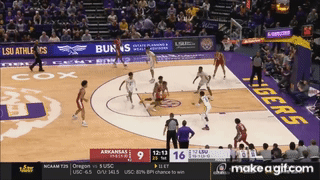
Chris Lykes’ defender stunts against Notae (pack line off-ball defenders tend to “stunt” instead of fully committing to the ball). This leaves Lykes open for a wide-open 3 after a kickout. It misses, but Devo Davis’ defender on the backside is not in position to box him out, leading to a quick putback.
#3 No Rim Protector
By design, pack line defenses don’t have a rim protector. So there’s no Walker Kessler to intimidate Arkansas’ guards. All positions have to play in the gaps. That’s why spacing is so important: it keeps shot blockers out of the lane.
Muss calls his offense “pace-and-space”, and the “pace” part is important too. The pack line needs to be set up to work properly. In first matchup, Arkansas attacked with Notae early in the shot clock, before LSU was in position:
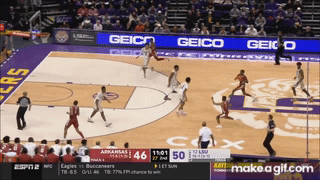
Notae splitting two stunting defenders is fun, but watch Trey Wade screen LSU’s shot blocker out of the play completely. That’s how it’s done.
When LSU has the rock

The Tigers may struggle to score against an Arkansas defense that is playing its best basketball right now. Just as LSU’s defense has gotten worse as the season has progressed, Arkansas’ has gotten better. The Hogs’ ADE was 94 on the morning of January 12th, the day of the first Mizzou game. It is just 90 now.
The Hogs have been strong at defensive rebounding and forcing turnovers all year. But the shooting defense took awhile to materialize. As of January 12th, opponents were shooting 52% Effective FG % against Arkansas: today, that figure is just 47%. Opponent 3-point shooting in particular has gone from 36% to 33% (54% EFG to 49%). In SEC games only, Arkansas actually has the best 3-point defense in the conference.
LSU plays at a rapid pace and crashes the offensive glass, making them very similar to Kentucky in terms of schematic approach. The difference is that LSU doesn’t shoot it nearly as well as Kentucky, but the biggest problem for LSU is turnovers. The Tigers give the ball away like king cakes at Mardi Gras, and as we saw above, their guards are particularly bad at turning it over. Arkansas has been putting opposing guards in jail in recent games:
- Kentucky: 27 points on 33 shot opportunities, 9 of 30 shooting, 7 turnovers
- Florida: 27 points on 40 shot opportunities, 12 of 37 shooting, 5 turnovers
- Tennessee: 39 points on 56 shot opportunities, 13 of 51 shooting (!!!), 11 turnovers
- Missouri: 35 points on 38 shot opportunities, 10 of 33 shooting, 11 turnovers
For reference, the D-I average for team points per shot opportunity (also known as True Shooting) is 1.06. None of these teams even managed 1.0 TS from their guards.
If LSU’s guards struggle, the game will come down to the Tiger forwards, namely Eason and Days. Eason is mentioned above, while Days is a more pedestrian shooter (51% EFG) but also one of only a few Tigers that doesn’t turn it over a ton.
Keys to the Game
- Clean up the defensive glass. There’s no Tshiebwe or Kessler for this game, but LSU’s offense is dependent on getting offensive rebounds. The Tigers will struggle to make shots and will turn it over, so second chances are their lifeline. The Hogs need to deny it.
- Pacing and spacing. “Stand around and watch Notae” is a poor strategy against LSU’s pack line defense. The Hogs to have good offensive spacing and make good passes to get LSU out of position. Attacking early in the shot clock before LSU can get set up is another good option.
- Keep Notae and Williams out of foul trouble. LSU simply isn’t at the level they were at earlier in the year. The Hogs are in a good position if they can keep their stars from having to ride the pine. Williams has had two first half fouls in three straight games, while Notae’s foul trouble against Alabama cost the Hogs dearly. Both need to stay out of trouble.
The latest from Fayette Villains, straight to your inbox
Enter your email to subscribe and receive new post alerts and other updates. You can unsubscribe at any time.
